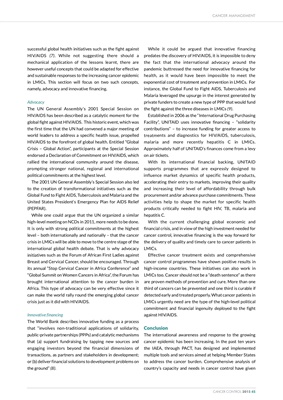
successful global health initiatives such as the fight against
HIV/AIDS (7). While not suggesting there should a
mechanical application of the lessons learnt, there are
however useful concepts that could be adapted for effective
and sustainable responses to the increasing cancer epidemic
in LMICs. This section will focus on two such concepts,
namely, advocacy and innovative financing.
Advocacy
The UN General Assembly's 2001 Special Session on
HIV/AIDS has been described as a catalytic moment for the
global fight against HIV/AIDS. This historic event, which was
the first time that the UN had convened a major meeting of
world leaders to address a specific health issue, propelled
HIV/AIDS to the forefront of global health. Entitled "Global
Crisis - Global Action", participants at the Special Session
endorsed a Declaration of Commitment on HIV/AIDS, which
rallied the international community around the disease,
prompting stronger national, regional and international
political commitments at the highest level.
The 2001 UN General Assembly's Special Session also led
to the creation of transformational initiatives such as the
Global Fund to Fight AIDS, Tuberculosis and Malaria and the
United States President's Emergency Plan for AIDS Relief
(PEPFAR).
While one could argue that the UN organized a similar
high-level meeting on NCDs in 2011, more needs to be done.
It is only with strong political commitments at the highest
level - both internationally and nationally - that the cancer
crisis in LMICs will be able to move to the centre stage of the
international global health debate. That is why advocacy
initiatives such as the Forum of African First Ladies against
Breast and Cervical Cancer, should be encouraged. Through
its annual "Stop Cervical Cancer in Africa Conference" and
"Global Summit on Women Cancers in Africa", the Forum has
brought international attention to the cancer burden in
Africa. This type of advocacy can be very effective since it
can make the world rally round the emerging global cancer
crisis just as it did with HIV/AIDS.
Innovative financing
The World Bank describes innovative funding as a process
that "involves non-traditional applications of solidarity,
public-private partnerships (PPPs) and catalytic mechanisms
that (a) support fundraising by tapping new sources and
engaging investors beyond the financial dimensions of
transactions, as partners and stakeholders in development;
or (b) deliver financial solutions to development problems on
the ground" (8).
While it could be argued that innovative financing
predates the discovery of HIV/AIDS, it is impossible to deny
the fact that the international advocacy around the
pandemic buttressed the need for innovative financing for
health, as it would have been impossible to meet the
exponential cost of treatment and prevention in LMICs. For
instance, the Global Fund to Fight AIDS, Tuberculosis and
Malaria leveraged the upsurge in the interest generated by
private funders to create a new type of PPP that would fund
the fight against the three diseases in LMICs (9).
Established in 2006 as the "International Drug Purchasing
Facility", UNITAID uses innovative financing - "solidarity
contributions" - to increase funding for greater access to
treatments and diagnostics for HIV/AIDS, tuberculosis,
malaria and more recently hepatitis C in LMICs.
Approximately half of UNITAID's finances come from a levy
on air tickets.
With its international financial backing, UNITAID
supports programmes that are expressly designed to
influence market dynamics of specific health products,
accelerating their entry to markets, improving their quality
and increasing their level of affordability through bulk
procurement and/or advance purchase commitments. These
activities help to shape the market for specific health
products critically needed to fight HIV, TB, malaria and
hepatitis C.
With the current challenging global economic and
financial crisis, and in view of the high investment needed for
cancer control, innovative financing is the way forward for
the delivery of quality and timely care to cancer patients in
LMICs.
Effective cancer treatment exists and comprehensive
cancer control programmes have shown positive results in
high-income countries. These initiatives can also work in
LMICs too. Cancer should not be a "death sentence" as there
are proven methods of prevention and cure. More than one
third of cancers can be prevented and one third is curable if
detected early and treated properly. What cancer patients in
LMICs urgently need are the type of the high-level political
commitment and financial ingenuity deployed to the fight
against HIV/AIDS.
Conclusion
The international awareness and response to the growing
cancer epidemic has been increasing. In the past ten years
the IAEA, through PACT, has designed and implemented
multiple tools and services aimed at helping Member States
to address the cancer burden. Comprehensive analysis of
country's capacity and needs in cancer control have given
CANCER MANAGEMENT
CANCER CONTROL 2015 45